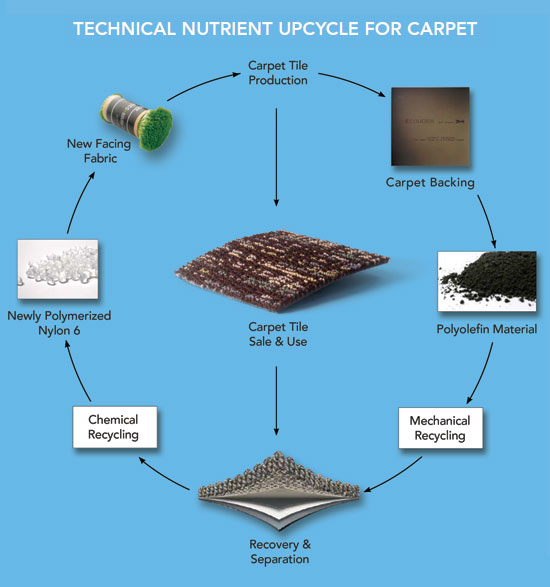Multi-Attribute Certification Pinpoints True Sustainability
Consistent with Cradle to Cradle principles, some leading manufacturers have designed their carpet products as technical nutrients that can remain in constant use, effectively “closing the loop.” According to its website, more than half of the carpet sold by the carpet manufacturer Shaw Floors is Cradle to Cradle Certified Silver. The company's technical nutrient carpet tile is designed to be returned to it after use and be perpetually recycled into the next generation of high quality carpet. In fact, the company will take back and recycle certain products at the end of their first use at no charge to the customer—a scenario made possible because the company is getting its raw materials back. This is a radical change in business model, and an example of how Cradle to Cradle design can fundamentally change business.
 |
One large carpet manufacturer has a fully operational Cradle to Cradle recycling system in which the carpet backing and yarn face are separated, broken down, and reprocessed. The backing becomes more backing, and yarn becomes more yarn, over and over again—with no compromise in aesthetics or performance. In this closed loop system, the recycled materials are returned into the same product that existed before recycling. Image courtesy of Shaw Floors; provided by Cradle to Cradle Products Innovation Institute |
Reclaiming carpet is no easy feat, though, and is dependent on economically feasible collection of an ample supply of old carpet and ways of reusing the material that make financial sense. Commercial and consumer customers alike need to be made aware of the recycling option. So far, manufacturers are seeing results.
Since 2008, European carpet and sports pitches manufacturer, Desso, has been learning how to move towards the less wasteful circular economy via its Cradle to Cradle commitment. This embraces a whole new way of looking at doing business in which goods are made out of the healthiest materials so they can be recycled in a healthy way at the end of the product's life.
The company offers a “Take Back” program to ensure that products can be recycled according to Cradle to Cradle principles. “'Take Back,'” explains the director of marketing, communications for Cradle to Cradle, Anette Timmer-Larsen, “introduces the concept of a product of service. Instead of the current paradigm in which goods are bought, owned, and disposed of, products containing valuable technical nutrients will be reconceived as new products that new consumers will wish to purchase. In that manufacturing scenario, customers are effectively buying the service of that product for a certain period and then, at the end of its useful life, the manufacturer takes it back, takes it apart and reuses its nutrients to make new products. Yes, we will still be in the business of selling products but, unlike now, we will retain responsibility for those products—to the end of their useful lives and beyond.”
Companies in other fields are following suit. One provider of window shading solutions, MechoSystems, for example, considers its shadecloth material as a technical nutrient. Typically, shadecloths are woven with a PVC jacket and a core of fiberglass or polyester core, which cannot be separated for reuse. But by using thermoplastic olefin (TPO) yarn, which is PVC-free, the company can reclaim the shadecloth once it has reached the end of its useful life, and indefinitely recycle it by melting it down and spinning it again into new, first-quality material. This approach also enables the immediate reuse of scraps during manufacture, diverting an estimated 1 million pounds per year that would otherwise go to landfills and incinerators.1
Continuous improvement in Material Reutilization is characterized by a progressive path towards total recovery, reuse, and upcycling, which is defined as converting waste or useless products into new materials or products of better quality or better environmental value. At the Basic level, materials are defined as an intended part of a biological or technical metabolism. Beginning at the Bronze level, the reutilization potential of the product is calculated as a score from 1 to 100, based on its cyclability and recycled or rapidly renewable content. At the Gold level, a nutrient management strategy is required to outline how a product is to be appropriately managed through proprietary, municipal, or cooperative commercial systems. Other changes in V3 include the designation of a Platinum rank in material reutilization signifying the product is being actively and successfully managed in complimentary metabolisms.









